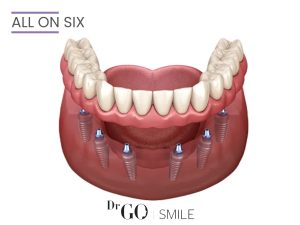
Dental implants have revolutionized the way we approach tooth replacement, offering patients solutions that are both functional and aesthetically pleasing. Among the various implant techniques, the All-on-4 and All-on-6 systems stand out as remarkable innovations for individuals requiring full-arch rehabilitation. This article explores these two methods, their benefits, and why they might be the right choice for patients seeking to restore their smiles and improve their quality of life.
Understanding All-on-4 and All-on-6
Both All-on-4 and All-on-6 systems provide patients with a complete set of fixed teeth using only four or six implants, respectively. This approach is particularly advantageous for those who have lost most or all of their natural teeth but still have sufficient bone structure to support implants.
All-on-4 involves placing four implants strategically within the jawbone. The two posterior implants are tilted, which allows for the use of longer implants, maximizing bone utilization even in cases where bone density is compromised. This technique significantly reduces the need for bone grafting procedures.
All-on-6, on the other hand, involves the placement of six implants, which provides additional stability and support. This option is particularly beneficial for patients with better bone density and those who desire extra security in their implant-supported prosthesis.
The Benefits of All-on-4 and All-on-6
- Immediate Functionality: One of the primary advantages of both systems is the ability to provide patients with immediate functionality. After the implants are placed, a temporary prosthesis can often be attached the same day, allowing patients to leave the clinic with functional teeth.
- Reduced Treatment Time: Traditional implant procedures can be lengthy and often require multiple visits. The All-on-4 and All-on-6 systems streamline this process, allowing for quicker treatment timelines without sacrificing quality.
- Bone Preservation: Both systems are designed to preserve existing bone structures. The tilted placement of implants in the All-on-4 technique, in particular, is beneficial for patients who have experienced bone loss, as it makes the most of available bone.
- Enhanced Aesthetics: With these systems, patients receive a natural-looking set of teeth that can significantly enhance their appearance. The fixed prosthesis mimics the look and feel of natural teeth, leading to increased self-confidence.
- Improved Quality of Life: The restoration of full dental function allows patients to enjoy their favorite foods again, speak clearly, and smile without hesitation. This has profound psychological benefits, improving overall well-being and social interactions.
The Procedure: What to Expect
The process begins with a thorough consultation, during which a dental professional will evaluate the patient’s oral health, bone structure, and personal needs. Advanced imaging techniques, such as cone beam computed tomography (CBCT), are used to assess bone density and plan implant placement accurately.
Once a treatment plan is established, the procedure itself typically involves the following steps:
- Implant Placement: Under local anesthesia or sedation, four or six implants are placed into the jawbone. The procedure usually takes a few hours, depending on the complexity.
- Temporary Prosthesis: After the implants are placed, a temporary prosthesis is attached. This allows patients to have a functional smile while the implants heal.
- Healing Period: The implants will integrate with the bone over a healing period of several months. During this time, patients will be monitored for proper healing and any potential complications.
- Final Prosthesis: Once healing is complete, a custom-made, permanent prosthesis is fabricated and placed over the implants, providing a durable and aesthetic solution.
Considerations and Aftercare
While All-on-4 and All-on-6 systems are highly successful, some factors should be considered. Patients must maintain good oral hygiene practices to ensure the longevity of their implants and prostheses. Regular dental check-ups and professional cleanings are crucial for monitoring the health of the gums and implants.
Additionally, patients should avoid habits that can compromise the implants, such as smoking and excessive alcohol consumption. A balanced diet rich in nutrients also supports healing and implant longevity.
Conclusion
All-on-4 and All-on-6 implant systems represent significant advancements in dental implant technology, offering patients a reliable and effective solution for complete oral rehabilitation. By understanding the benefits and the procedure, patients can make informed decisions that align with their needs and lifestyle. As with any dental procedure, consulting with a qualified dental professional is essential to ensure the best outcomes. Embracing these innovations can lead to improved oral health, enhanced aesthetics, and a renewed sense of confidence for many individuals.


